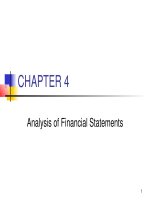Lecture Managerial economics - Chapter 4: Four possible markets
Bạn đang xem bản rút gọn của tài liệu. Xem và tải ngay bản đầy đủ của tài liệu tại đây (1.66 MB, 39 trang )
WEEK 4
FOUR POSSIBLE MARKETS
1.
Perfect Competition (price-takers)
2.
Monopolistic Competition (price-searchers)
3.
Oligopoly (a few firms dominate)
4.
Monopoly (single seller)
1
PERFECT COMPETITION
Many firms in the industry
and no barriers to entry
(exit)
We learned that
competitive market is the
best for the society
PS+CS is maximized
2
COMPETITIVE EQUILIBRIUM
Perfect Competition market
1.Large market with many firms and consumers
2. No barriers to entry (exit)
3. All firms produce an identical, homogenous, standardized
product
4. Firms are “price takers” (the market price is given)
5. Consumers are also price takers
6. Output rule: MR = MC to max profits
7. Social efficiency
3
PRICE FOR A COMPETITIVE FIRM
A competitive
firm can keep increasing its output
without affecting the market price.
So,
each one-unit increase in Q causes revenue
to rise by P, i.e., MR= P.
MR=
P is only true for firms in competitive
markets.
4
MC & THE FIRM’S SUPPLY DECISION
MR= MC at the
profit-maximizing Q.
At Qa, MC< MR. So,
increase Q to raise profit.
At Qb, MC> MR. So,
reduce Q to raise profit.
At Q1, MC= MR.
Changing Q would lower
profit.
Rule:
5
SHUTDOWN VS. EXIT
A short-run decision not to
produce anything because of market
conditions.
Exit: A long-run decision to leave the
market.
A firm that shuts down temporarily must
still pay its fixed costs. A firm that exits the
market does not have to pay any costs at
all, fixed or variable.
Shutdown:
6
A FIRM’S SHORT RUN DECISION TO SHUT DOWN
If
firm shuts down temporarily,
revenue falls by TR
costs fall by VC
So, the firm should shut down if
TR< VC.
TR/Q< VC/Q
So we can write the firm’s decision as:
Shut down if P< AVC
7
A FIRM’S LONG RUN DECISION TO EXIT
If
firm exits the market,
revenue falls by TR
costs fall by TC
So, the firm should shut down if
TR< TC.
So
we can write the firm’s decision as:
Exit if P< ATC or Enter if P>ATC
8
EXAMPLE: AIRLINE REGULATION
1.
The regulations in airline industry in 1970s were restricted
entry and set fares higher the free market prices?
2. The effect of deregulation: the # of carriers increased
dramatically.
3. The government imposing the price control in the first place
was to provide “stability” in an industry that was considered
vital to the U.S economy.
9
AIRLINE REGULATION
The airfare was regulated at
P_min
CS = A
, PS = B+C
Deregulation (free market)
CS = A+B+D, PS =C+E
Which is better for economy?
10
CURRENT DEREGULATION?
From www.deregulation.com,
1. Telecom Service
• The FCC received a legislative directive from Congress to
deregulate the telecommunication industry in 1996 - the first
major change to telecommunications law in the United States in
over 64 years – the Telecommunications Act of 1996, P.L. 98104-104, 110 Stat. 56 (1996).
2. Gas
• Commencing with the Natural Gas Policy Act of 1978 (NGPA),
Congress ended federal control over gas prices at the wellhead.
3. Electricity
• Deregulation is taking place state by state.
11
OPEN ECONOMY VS. CLOSED ECONOMY
Which is the best for the domestic
economy?
a. Free Trade (Open Economy)
b. Closed Economy (No Imports)
c. Import Quota (Allow Certain Amount of Imports)
d. Import Tariff (Tax on Imports)
Consumers pay the lowest price, when?
Consumers consume the most, when?
12
CASE 1. FREE TRADE (NO IMPORT RESTRICTIONS)
Government does not restrict imports at all.
• ex. Trade between European Union (EU) countries
• ex. NAFTA
Compared to all other cases,
• P is lowest & Q is highest
• So consumers like this case best and CS is highest.
• PS is lowest, so domestic producers like this case least
–low domestic production, large imports
• Best for the country (& society) as a whole.
13
CASE 2: CLOSED ECONOMY (NO IMPORTS)
Government allows no imports whatsoever.
• ex. North Korea
Compared to all other cases,
• P is highest & Q is lowest
• consumers hate this case and CS is lowest.
• PS is highest, so domestic producers like this case best
–But domestic producers will operate
inefficiently.
• worst for the country (& society) as a whole.
14
CASE 3. IMPORT QUOTA (PARTIAL RESTRICTION)
Government allows fixed amounts of imports
• this & the next case are intermediate between Cases 1 & 2
• ex. Quota on Japanese car imports
Compared to all other cases,
• P & Q are between the free trade & closed economy cases
• CS is between the free trade & closed economy cases
• PS is between the free trade & closed economy cases
• CS + PS is also between the free trade & closed economy
cases
How about the effect on foreign producers?
• Are they better off than in the case of closed economy?
15
CASE 4. IMPORT TARIFF
Government allows all imports. However, it taxes them by T
per unit. But doesn’t tax domestic production.
• ex. Most countries impose tariffs.
Compared to all other cases,
• P, Q, CS, PS are all the same as in Case 3
• between the free trade & closed economy cases
What is the difference from Case 3?
• government gets revenue from tariffs
• In case 3, the revenue would have gone to the foreign
suppliers
– thus, domestic economy is better off than in Case 3
16
INTERNATIONAL TRADE
A closed economy is the worst case
Free market
• Free trade is best for the country b/c largest total
surplus
Import quota / tariffs benefit domestic (& sometimes
foreign!) producers, at the expense of consumers
• domestic firms often lobby for import restrictions
Tariffs are better for the domestic economy than quotas
• Tax revenue goes to the government instead to
foreign producers.
17
EVIDENCE: AUTO INDUSTRY
Beginning in 1981, Voluntary Export Restraint
(VER) on Japanese car imports to US (Case 3).
What happened?
• Japanese manufacturers (importers)
–Q fell to the quota imposed
–P rose by $1000; total revenue rose by $2 billion
–shifted toward higher quality cars (why?)
• US producers
–Q rose by 500,000; P rose by $400; created 26,000 new jobs
• US consumers
–consumed fewer cars; but paid $4.3 billion more
• US social cost of each job: $4.3B/26,000 = $160,000
• Who is the winner? loser?
18
SUMMARY
1. Deregulation
– Sometimes price control can be helpful, but not often.
– So deregulation is better for the society.
2. International Trade
– Open economy is best for the society.
– Government sometimes impose import quota / tariff to
protect firms.
– Foreign producers also get benefits from the import
quota /tariffs.
19
MARKET FAILURE
Public Goods & Externality
20
AGENDA
We learned free (competitive) markets are usually good for the
society.
But sometimes a free (competitive) market may
not achieve social optimal. This is called “Market Failure.”
• 2 cases : public goods and externality
• government policies may be justified (assuming
government policies are effective)
21
MARKET FAILURE 1. PUBLIC GOODS
Public Goods: Simply speaking, goods that are open
to use by all consumers
• Examples
– national defense
– law and order
– public parks
– roads and streets
– open wi-fi services
• Since nobody can be excluded from public goods, it’s hard for private
companies to make profits.
• As a result, no firm will provide these services (which is not optimal)
• In such cases government might be justified in providing the goods
(and it can do so because of the power to raise taxes).
22
MARKET FAILURE 2. EXTERNALITIES
Externality: a cost or benefit imposed on the society, but not
directly reflected in the market
• negative externalities (cost)
–Pollution
–Baseball stadium near residential areas
• positive externalities (benefit)
–Landscaping (planting trees, maintaining nice lawns)
–Baseball stadium near commercial areas
Any examples of externality?
23
EX 1. POLLUTION: NEGATIVE EXTERNALITY
24
EX 2. HIGHER EDUCATION: POSITIVE EXTERNALITY
25









